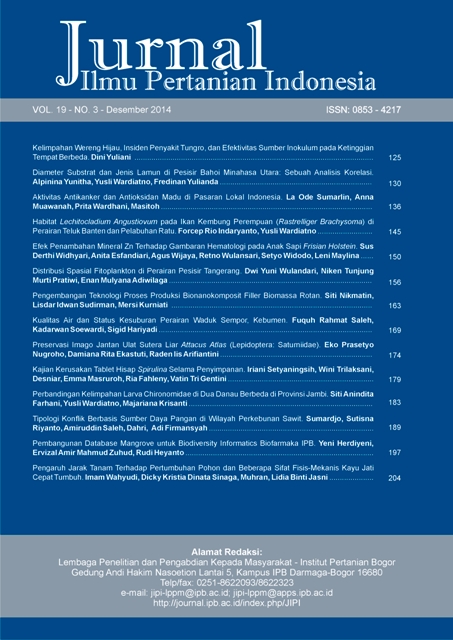Diameter Substrat dan Jenis Lamun di Pesisir Bahoi Minahasa Utara: Sebuah Analisis Korelasi
Abstract
Substrate has an important role for growing and surviving of seagrass as a medium of life and as a supplier of nutrients. Lack of attention towards seagrass is because of less information related to the seagrass ecology itself. The aim of this study is to determine the influence of substrate diameter with it’s density. The study was conducted in April in Bahoi coastal, North Minahasa District, North Sulawesi. This study measured water quality, substrate sampling were taken in the field. The result showed that 6 seagrass species: Enhalus acoroides, Thalassia hemprichii, Halodule uninervis, Cymodecea rotundata, Syringodium isoetifolium, Halpohila ovalis, with good water quality and sand substrate types. This coastal area was dominated by small-sized seagrass. The highest density was found at station B with seagrass type was S. isoetifolium and lowest was at station C with E. acoroides and Sand substrate which had big diameter, type T. hemprichii had high density.
Downloads
References
Abdi H, Williams LJ. 2010. Principal Component Analysis. Wiley Interdisciplinary Reviews: Computational Statistics. 2(4): 433-459.
Anderson WT, Fourqurean JW. 2003. Intra-and interannual varoability in seagrass carbon and nitrogen stable isotopes from South Florida, a preliminary study. Organic Geochemistry. 34(2): 185-194.
Athiperumalsami T, Kumar V, Jesudass LL. 2008. Survey and phytochemical analysis of seagrass in the gulf of mannar, Southeast Coast of India. Botanica Marina. 51(4): 269-277.
Azkab MH. 1999. Pedoman inventarisasi lamun. Oseana. 24(1): 1-16.
Barbier EB, Hacker SD, Kennedy C, Koch EW, Stier AC, Silliman BR. 2011. The value of setuarine and coastal ecosystem services. Ecological Monographs. 81(2): 169-193.
Benstead JP, March JG, Fry B, Ewel KC, Pringle CM. 2006. Testing isosource: stable isotop analysis of a tropical fishery with diverse organic matter sources. Ecilogical Society of America. Ecology. 87(2): 326-333.
Brower JE, Zar NJ. 1977. Field and Laboratory Method for General Ecology. Wm.C Brown Pub, Dubuque, Iowa (US).
Datta D, Chattopadhyay RN, Guha P. 2012. Community based mangrove management: A review on status and sustainability. Journal of Environmental Management. 107: 84-95.
De Silva KHWL, Amarasinghe MD. 2007. Substrate characteristics and species diversity of marine angiosperms in a micro-tidal basin estuary on west coast of Sri Lanka. Sri Lanka Journal Aquatic Sciences. 12: 103-114.
Fourqurean JW, Willsie A, Rose CD, Rutten LM. 2001. Spatial and temporal pattern in seagrass community composition and productivity in south Florida. Marine Biology. 138(2): 341-354.
Frasiandini I, Puspawati RP, Indah NK. 2012. Struktur morfologi dan anatomi Syringodium isoetifolium di Pantai Kondang Merak Malang. Lentera Bio (Berkala Ilmiah Biologi). 1(2): 67-74.
Hartati R, Djunaedi A, Haryadi, Mujianto. 2012. Struktur komunitas padang lamun di Perairan Pulau Kumbang, Kepulauan Karimunjawa. Ilmu Kelautan. 17(4): 217-225.
Hashim M, Abd. Rahman R, Muhammad M, RM, Abd. Wahid. 2001. Spectral characteristics of seagrass with landsat TM in Northern Sabah Coastline, Malaysia. Asian Conference on Remote Sensing 22nd; 5-9 November. Singapore.
Hori M, Suzuki T, Monthum Y, Srisombat T, Tanakan Y, Nakaoka M, Mukai H. 2009. High seagrass diversity and canopy-height increase associated fish diversity and abundance. Marine Biology. 156(7): 1447-1458.
Keputusan Menteri Negara Lingkungan Hidup No. 51. 2004. Baku Mutu Air Laut Untuk Biota Laut. Lamp.3.
Kiswara W, Moosa MK, Hutomo M. 1994. Struktur Komunitas Biologi Padang Lamun di Pantai Selatan Lombok dan Kondisi Lingkungannya. Pusat Penelitian dan Pengembangan Oseanologi, Lembaga Ilmu Pengetahuan Indonesia. Jakarta (ID): 34-41.
Kiswara W. 1997. Struktur Komunitas Padang Lamun Perairan Indonesia. Inventarisasi dan Evaluasi Potensi Laut-Pesisir II, Jakarta (ID): P3O LIPI. 54-61.
Koch EW, Sanford LP, Chen Shih-Nan, Shafer DJ, Smith JM. 2006. Waves in Seagrass Systems: Review and Technical Recommendations. System-Wide Water Resources Program, Submerged Aquatic Vegetation Restoration Research Program. Washington (US) : 92.
Lee KS, Park SR, Kim YK. 2007. Effect of irradiance, temperature, and nutrients on growth dynamics of seagrasses: A Review. Journal of Experimental marine Biology and Ecology. 350 (1-2): 144-175.
McKenzie L. 2008. Seagrass Educators Handbook. Northern Fisheries Centre. Australia (AU).
Newmaster AF, Berg KJ, Ragupathy S, Palanisamy M, Sambandan K, Newmaster SG. 2011. Local knowladge and conservation of seagrass in the Tamil Nadu State of India. Journal of Ethnobiology and Ethnomedicine. 7: 37.
Peterson BJ, Heck KL Jr. 1999. The potential for suspension feeding bivalves to increase seagrass productivity. Journal of Experimental Marine Biology and Ecology. 240(1): 37-52.
Philips RC, Milchakova NA. 2003. Seagrass ecosystems. Biology and Ecology. 350: 3-20.
Ruiz JM, Romero J. 2003. Effects of distrubances caused by coastal construction on spatial structure, growth dynamics and photosynthesis of the seagrass Posidonia oceanica. Marine Pollution Bulletine. 46(12): 1523-1533.
Short F, Carruthers T, Dennison W, Waycott M. 2007. Global seagrass distribution and diversity: a bioregional model. Journal of Experimental Marine Biology and Ecology. 350(1): 3-20.
Takaendengan K, Azkab MH. 2010. Struktur komunitas lamun di Pulau Talise, Sulawesi Utara. Oseanologi dan Limnologi. 36(1): 85-95.
Torquemada YF, Durako MJ, Lizaso JLS. 2005. Effects of salinity and possible interactions with temperature and pH on growth and photosynthesis of Halophila johnsonii Eismen. Marine Biology. 148(2): 251-260.
Watson RA, Coles RG, Long WJL. 1993. Simulation estimates of annual yield and landed value for commercial penaeid prawns from a tropical seagrass habit, Northern Queensland, Australia. Australian Journal of Marine and Freshwater Research. 44(1): 211-219.
Waycott M, McMahon K, Mellors J, Calladine A, Kleine D. 2004. A Guide to Tropical Seagrasses of the Indo-West Pacific. James Cook University, Townsville (AU).
This journal is published under the terms of the Creative Commons Attribution-NonCommercial 4.0 International License. Authors who publish with this journal agree to the following terms: Authors retain copyright and grant the journal right of first publication with the work simultaneously licensed under a Creative Commons Attribution-NonCommercial 4.0 International License. Attribution — You must give appropriate credit, provide a link to the license, and indicate if changes were made. You may do so in any reasonable manner, but not in any way that suggests the licensor endorses you or your use. NonCommercial — You may not use the material for commercial purposes.



















